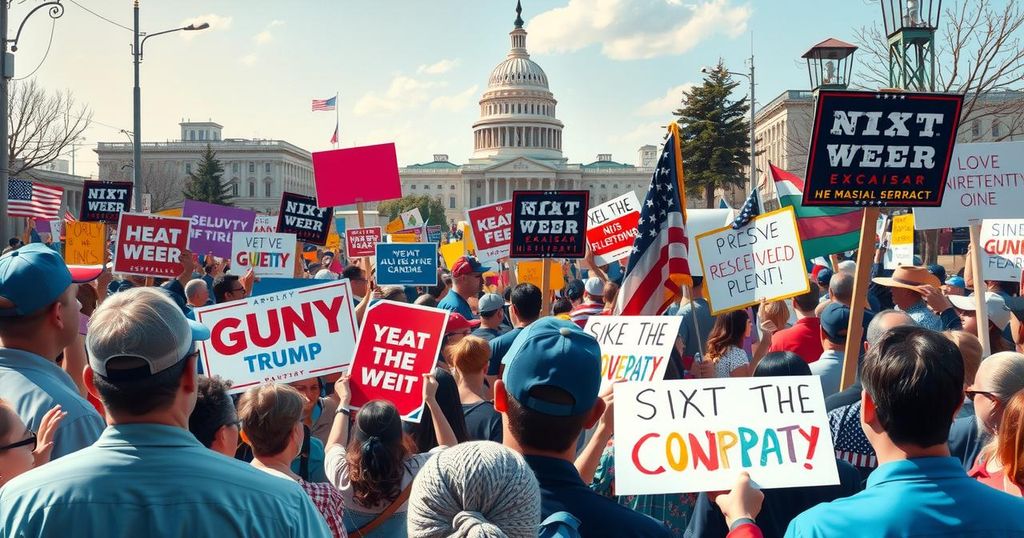Democrats Struggle for Influence Amid the Trump Agenda
- Democrats struggle to fight the Trump agenda with limited power.
- Rallies highlight the tension between Democrats and their constituents.
- Lawmakers express frustrations over limited legislative leverage.
- House Democrats want a clear narrative to counter Trump’s agenda.
- Judicial approaches are gaining traction among Democratic lawmakers.
Democrats Struggle to Amplify Their Voices Amidst Challenges
Amid rising tensions and a vocal base demanding greater action, congressional Democrats are grappling with their power limitations as the party in the minority. Recent protests have seen a chorus of frustrated voices demanding accountability and urgency in combating the actions of the Trump administration. During a rally related to the furlough of nearly all U.S. Agency for International Development employees, a group of lawmakers found themselves somewhat drowned out by chants of “Do your job”. This clash between desperate constituents and a restrained party identity reflects an uphill battle as Democrats try to carve out a space against the tide of a unified Republican government.
Tensions Between Constituents and Congressional Action Rise
House Minority Leader Hakeem Jeffries expressed the sentiment shared by many where he argued, “What leverage do we have? Republicans control the House, Senate, and presidency.” This reality resonates deeply, with many constituents failing to fully grasp how the Republican Party’s control stifles Democratic efforts in Congress. A disconnect has emerged as lawmakers report busy phone lines filled with calls demanding action against the Trump agenda, while they themselves feel limited in what they can achieve. The situation leaves lawmakers like Representative Becca Balint feeling frustrated, explaining how she frequently encounters constituents who seem unaware of the power dynamics in play within Congress.
Constructing a Strong Narrative to Counter The Administration
Nevertheless, Democrats are not completely resigned to their fate. Some argue that rather than solely focusing on their limitations, the party should innovate and create a resonant narrative that vividly contrasts them with the Trump administration’s direction. Rep. Adam Smith emphasises the necessity of constructively engaging the public by painting a picture of Trump’s quest for autocratic power, one that is more for himself rather than the American people. Meanwhile, Senate Democrats are set to tackle a budget resolution, an opportunity to refine their messaging and put GOP senators on record about contentious matters surrounding the Trump agenda. This could be pivotal for Democrats as they work to unify around critical issues and underline their perspectives as the opposition party.
Democrats Seek Legal Remedies While Engaging Constituent Concerns
While facing legislative challenges, Democrats are also keeping a close eye on judicial avenues to stall some of the Trump administration’s maneuvers. Rep. Melanie Stansbury highlighted that lacking legislative power pushes them to adopt court challenges as a means to delay or stop unfavourable actions. This is where state attorneys general and advocacy groups come into play, actively contesting measures like birthright citizenship adjustments and other federal actions. In a show of solidarity, Rep. Jamie Raskin noted that caucus members would be actively involved in drafting amicus briefs as a concerted effort to fight back against unwarranted policies. With all this in motion, clear communications efforts are ramping up as Democratic representatives hold town halls to address constituents’ concerns regarding new federal policies.
Leveraging Future Opportunities Amid Divisions Within The Party
Democrats are also getting organized with the formation of a rapid-response task force led by Rep. Joe Neguse, aiming to steer the narrative on the administration’s controversial actions. Neguse articulated hopes for pushing legislative measures that would mitigate the fallout of Trump’s policies. Time is critical, he said, as conversations about government funding approaches the March 14 deadline. That said, there’s an apparent divide within the Democratic ranks on whether to leverage their voting power responsibly to avoid the potential blame associated with a government shutdown. Ultimately, a shared commitment to cultivating a responsive stance among constituents could influence both public opinion and the party’s approach moving forward, all while navigating treacherous political waters.
The article paints a picture of Congress’s current state where Democrats are striving to find their footing while attempting to tackle the Trump agenda with minimal power as a minority party. With frustrated constituents eager for action and a party leadership contemplating strategies from legal recourse to communications, the upcoming months will be crucial in determining how effectively they can resonate with their base and push back against the administration’s moves. Time will tell if Democrats can successfully harness public sentiment and navigate their internal divisions in a significant way or if they will continue facing an uphill battle.




